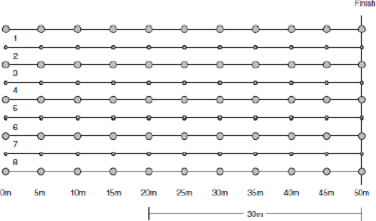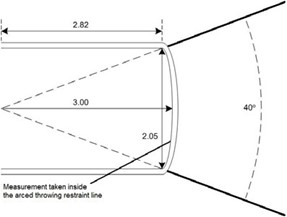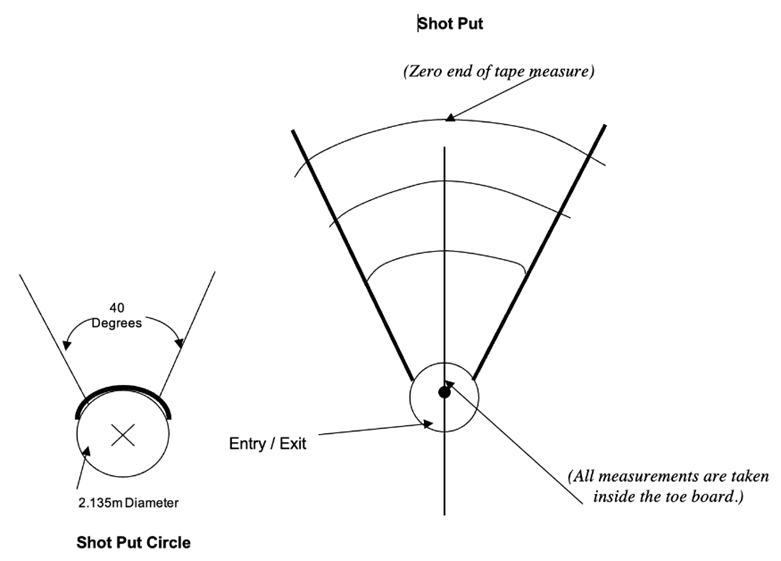Athletics Rules
Valid through 2025
*Addendums added since last rules update (also highlighted in yellow):
- Standing Long Jump added under Category 2 events in addition to Category 1
Special Olympics New Hampshire has created this set of rules based on the rules outlined by Special Olympics International as well as World Athletics, which is the National Governing Body for Athletics.
These rules shall be used to govern all Special Olympics New Hampshire Athletics competition through the end of 2025 when we next review these rules.
Events Offered
Category 1
- 10 Meter Electric Wheelchair
- 10 Meter Manual Wheelchair
- 10 Meter Walk w/ Support
- 10 Meter Walk
- 25 Meter Electric Wheelchair
- 25 Meter Manual Wheelchair
- 25 Meter Run
- 25 Meter Walk
- 25 Meter Walk w/ Support
- 30 Meter Electric Wheelchair Slalom
- 25 Meter Run w/ Support
- 50 Meter Walk
- 50 Meter Walk w/Support
- 50 Meter Wheelchair- Electric
- 50 Meter Wheelchair- Manual
- 100 Meter Wheelchair- Electric
- 100 Meter Wheelchair- Manual
- 100 Meter Walk w/ Support
- 200 Meter Manual Wheelchair
- Standing Long Jump
- Softball Throw
- Tennis Ball Throw
- Wheelchair Shot Put
Category 2
- 50 Meter Walk
- 50 Meter Run
- 100 Meter Walk
- 200 Meter Walk
- 400 Meter Walk
- Mini-Javelin
- Softball Throw
- Tennis Ball Throw
- Shot Put
- Standing Long Jump
- Running Long Jump
Category 3
- 50 Meter Run
- 100 Meter Run
- 200 Meter Walk
- 200 Meter Run
- 400 Meter Run
- 400 Meter Walk
- 4×100 Meter Relay
- 4×100 Meter Unified Sports Relay
- Mini-Javelin
- Shot Put
- Softball Throw
- Running Long Jump
Category 4
- 200 Meter Run
- 400 Meter Run
- 800 Meter Run
- 800 Meter Walk
- 1500 Meter Walk
- 1500 Meter Run
- 4×100 Meter Relay
- 4×100 Meter Unified Sports Relay
- Pentathlon
- Mini-Javelin
- Shot Put
- High Jump
- Running Long Jump
Registration
- Athletes may only compete in one of the categories listed above.
- Athletes may compete in walking and running events if they are in the same category.
- Athletes may compete in up to four events.
- Athletes may only register for one of the following events: tennis ball throw, softball throw or shot put.
- Athletes may only register for one of the following events: running long jump or standing long jump.
- Athletes with Down syndrome who have been diagnosed with Atlanto-axial instability may not participate in the pentathlon and high jump events.
Divisioning
- Events that overlap categories will be heated together.
Equipment
Equipment, with the exception of an athlete’s uniform, will be provided at Area and State level competition. Local Programs are responsible for equipment needed for training leading up to competition.
Uniform
- Athletes must wear athletic clothing and sneakers. No jeans allowed.
- Bibs must be worn on the front of shirt/uniform and must be pinned down on all four corners.
Shot put
- The shot may be steel, brass, or a synthetic-covered implement. Shot put sizes are as follows:
- Wheelchair (Men & Women): 1.81kg (4lbs)
- Female (8-11): 1.81 kg (4 lbs)
- Male (8-11): 3.0 kg (6.6 lbs)
- Female: 3.0 kg (6.6 lbs)
- Male: 4.0 kg (8.8 lbs)
Softball throw
- A softball with a 30 centimeter (11 3/4 inches) in circumference shall be used.
Tennis ball throw
- A tennis ball shall be used.
Mini-javelin
- The minimum weights shall be:
- Male 16+: 400g
- Male 8-15 years and female: 300g
- The shaft, grip and fins shall be made out of plastic.
- There are 4 fins. The fins shall be flat (without protrusions or roughness) and shall be perpendicular to the surface of the mini-javelin.
- The tip shall be made of soft rubber with a blunt, rounded end.
Running events
- The option of using blocks will be available.
Competition
GENERAL RULES
- With support: An athlete needs the assistance of another individual and/or uses a device (i.e. canes, crutches, or walker). The assistance from another individual is for balance only and cannot provide forward momentum. An individual providing assistance may not be in front of the competitor at any time.
- Starting Race/Commands
- Starting race commands shall be “on your marks”, “set”, and when all competitors are steady, the gun shall be fired.
- In all other running events, all walking events and all wheelchair races the commands shall be “on your marks” and when all the competitors are steady, the gun shall be fired. A competitor shall not touch the ground with his/her hand(s) unless they are using starting blocks.
- An athlete with sensory sensitivities may request use of a whistle for a start instead of a gun.
- For athletes who are blind or deaf:
- A rope or sighted guide runner may be provided to assist athletes who are visually impaired.
- A sighted guide runner may not be ahead of the athlete in any manner. At no time may the guide runner pull the athlete or propel the athlete forward by pushing.
- A tap start will be used for an athlete who is both deaf and blind.
- Guide runners must wear a bright orange running vest so that they are clearly distinguished from competitors. These vests will be provided.
Pentathlon:
- The five events of the Pentathlon should be done in the following order: 100-meter run, long jump, shot put, high jump, and 400-meter run.
Race Walking:
- An athlete must have one foot in touch with the ground at all times.
- In all race walking events, an athlete does not have to have a straight advancing leg while competing.
Jumping Events:
- In the high jump, long jump and standing long jump, each athlete shall be allowed three non- consecutive attempts. The longest attempt shall be used for scoring. In the case of ties, the second longest score shall be used.
- Distance will be measured in meters along a perpendicular line from the starting line to the closest impression on the landing area made by any part of the body or limbs for all jumps.
- For Standing Long Jump competition,
- competition will be conducted on a grass (or similar) surface.
- a competitor will use both feet on the take-off. He/she may rock backward and forward lifting his/her heels and toes alternately, but he/she may not lift either foot completely off the ground.
- For Running Long Jump competition,
- an athlete must be able to jump at least 25cm, which is the distance between the take-off board and the sand pit.
- For High Jump competition,
- competitor will take off from one foot
- the minimum opening height shall be even with the landing mat.
- Competitors should not dive forward over the bar or take off from a two-footed take-off.
Throwing Events:
- In shot put, softball throw, mini-javelin, and tennis ball throw, each athlete shall be allowed three non-consecutive attempts. The longest attempt shall be used for scoring.
- In softball throw and tennis ball throw, competitors may use any type of throw.
- All throws will be measured in meters. Throws should be measured in a straight line from the inside of the arced throwing restraint line to where the ball or mini-javelin land (not a diagonal line).
- Shot-put:
- The shot shall be put from the shoulder with one hand only. When the competitor takes a stance in the circle to commence a put, the shot shall touch or be in close proximity to the neck or the chin and the hand shall not be dropped below this position during the action of putting. The shot shall not be taken behind the line of the shoulders.
- A legal put shall be made from within the circle. During an attempt, an athlete may not touch the top edge of the stop-board, the top of the iron ring or any surface outside of the circle. It is legal to touch the inside of the stop-board or the iron ring.
- Athletes may not use any mechanical aids, but for protective purposes only wrists may be taped.
- Mini-Javelin:
- The mini-javelin must be held by the grip with one hand only.
- The mini-javelin shall be thrown over the shoulder or upper part of the throwing arm and may not be slung or hurled.
- At no time may the competitor turn completely around so that his/her back is towards the throwing area.
- The measurement of each throw shall be made from where the tip first struck the ground to the inside edge of the arc.
- It is counted as a foul if the competitor:
- Does not use the proper throwing technique.
- Does not throw the mini-javelin so that the point (tip) lands before any other part of the implement.
- Does not throw the mini-javelin so that the point (tip) falls completely within the inner edges of the sector lines.
- Where the competitor touches with any part of the body the arc as marked, or any ground beyond the arc or throwing box.
COURSE LAYOUT
30-meter wheelchair slalom
- Beginning at the start line, place one cone in each lane at 5-meter intervals. Cones should be placed in the middle of the lanes. See image below:

Softball throw, tennis ball throw, and mini-jav:

- The throwing area should be set up as follows:
- The runway shall be marked by two parallel white lines 5 centimeters wide and 2.05 meters apart (2.82 meters in length).
- The throw shall be made from behind the arc of a circle drawn with a radius of 3.00 meters.
- The landing sector shall be marked with white lines 5 centimeters wide such that the inner edge of the lines, if extended, would pass through the two intersections of the inner edges of the arc, and the parallel lines marking the runway and intersect at the center of the circle of which the arc is part.
- The center of the circle is the point for the measurement and shall be marked. The sector is 40°.
- For Shot Put:

- For Walk with Support:
- Each athlete will use two lanes as his/her lane, sufficiently wide enough to allow for assistive devices.
- Place cones on the start and finish lines, 2.44 meters apart (two track-lanes width) to create four start and four finish gates and four lanes.
- Beginning at the start line, place one cone on each lane line at 5-meter intervals. Cones should be placed in the middle of the lane line.
RACE PROCEDURE
- For 800-Meter Run and greater distances, a waterfall start shall be used.
- For Wheelchair Races and Events:
- Athletes shall start with all wheels behind the start line and are timed from the start to when all front wheels (two or one) of the wheelchair reach the perpendicular plane of the nearer edge of the finish line.
- Motorized wheelchairs shall not be allowed in manual wheelchair races.
- Athletes shall not be pushed, pulled, or otherwise assisted during these events.
- The lanes for the wheelchair events shall be made two track-lanes wide.
- Each competitor must keep in his/her lane from start to finish and may not interfere, obstruct or impede the progress of another competitor. Infractions, at the discretion of the judges, may result in disqualification.
- For 30-Meter Wheelchair Slalom:
- Athlete maneuvers his/her chair through the course, going to the right of the first obstacle and across the finish line without impeding another athlete on the course.
- Knocking down a marker constitutes a violation, and a three-second penalty will be assessed.
- Each athlete will use two lanes as his/her lane, sufficiently wide enough to allow for wheelchairs.
- Place the cones on the start and finish lines 2.44 meters apart (two track-lanes width) to create four start and four finish gates and four lanes.
- Beginning at the start line, place one traffic cone (slalom flagpoles minimum of 1.22 meter) in each lane at 5-meter intervals. Cones should be placed in the middle of the lanes.
- Athlete maneuvers his/her chair through the course, going to the right of the first obstacle and across the finish line without impeding another athlete on the course. Knocking down a cone constitutes a violation, and a three-second penalty will be assessed.
- No penalty will be incurred as a result of touching/moving a cone.
RELAY PROCEDURE
- Relays may have one alternate athlete and one alternate partner. The scores of the alternate may not be faster than whom they are replacing. No other substitutions are allowed.
- Each Unified Sports relay team shall consist of two athletes and two Unified partners.
- For a 4×100 meter relay, any runner waiting for an incoming team member (with a baton) is not permitted to run outside his/her take-over zone and shall start within the exchange zone.
Disqualification
- Items listed below will result in disqualification:
- Competitors leaving their lane (except for the 800-meter & 1500-meter in which the runner will run in the lanes through the first turn as far as the nearer edge of the break line where athletes may leave their respective lanes.)
- Competitors impeding another’s progress
- Intentionally or improperly interfering with another competitor
- Preventing another competitor from passing
- Pacing of competitors
- In a race, making 2 false starts
- In a relay, making an improper exchange of the baton outside of the designated relay exchange area
- In jumping events, making 3 fouls taking off beyond the takeoff line or from outside either the end of the board; or in the course of landing, the athlete touches the border of or ground outside the landing area
- In jumping events, not landing a legal jump by the third attempt
- Not having one foot touching the ground at all times in race walking events
- Not wearing the proper uniform attire (no jeans are allowed)
